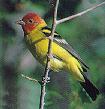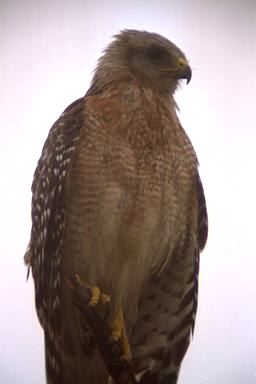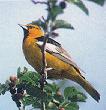photo © copyright James E.Kuhn
BIRDS
One of the most unique features of the Spenceville Wildlife Area is that many birds visit or make their home in the oak woodlands, grasslands, and the riparian corridors of Dry Creek and its tributaries. Any time of year, you can spot hawks and falcons on patrol overhead and, during mating season, you may even witness them performing an aerial ballet of courtship displays. Many varieties of songbirds, including finches, sparrows, warblers, chickadees, and wrens, also rely on the quality habitats of Spenceville. Spenceville can boast of an impressive 175 bird species observed within its borders with some 80 known nesting species.
Spenceville is not only an important area for permanent, year-round species, but is also an essential stopover (for feeding and resting) for those migrating species which nest in more northern latitudes and pass through again on their way back to the tropics for the winter. Spenceville also offers critical refuge for high elevation birds to escape from the harsh winter extremes of their resident territories. This is also true for valley species temporarily moving up to the foothills to escape the hot temperature extremes of summer.
The following list is a brief representation of some of the birds in the Spenceville Wildlife Area. Quietly and slowly walk, listen, and watch for any little indication of movement and sound. And with your field guide in hand, stealthily approach for a glimpse into the wondrous, secretive lives of birds.
Western Meadowlark. A relative of the blackbird, the meadowlark is a proud little fellow with sunny yellow plumage and a black, V-shaped bib. Whether he’s alone or in a group, peering over tufts of grass or perched on a fence-post, it is always poignant, yet delightful, to hear his rippling, flute like melody. Spenceville offers ideal habitat in that this species requires vast areas of grassland. Their population is currently experiencing an alarming decline.
Band-tailed Pigeon. Not to be confused with the pigeons sitting atop our city park statues, this is a very elegant and large bird (size of a small duck). A denizen of mountainous regions, usually in mixed evergreen/deciduous forest, it moves downslope to Spenceville during the harsh winter extremes at higher elevations. A bird of striking plumage with its body cloaked in shades of gray, light plum-colored head and chest, dark, iridescent green feathers on the back of its neck topped with a white, crescent-shaped nape band, and a dark, broad band across its tail feathers – hence its name. Can swallow 2" acorns whole.
Mourning Dove. A common and widespread species often seen in grassy fields and alongside roads eating the seeds of grasses, wildflowers, and weedy plant species. A very gentle and docile bird whose mournful, yet soothing, call gives this bird its name. A common game bird hunted in numbers that exceed all other game species combined. Size of a robin with dark to pale gray on body with pinkish wash on breast. A whistling sound is heard during flight as wind rushes between the feathers of its long V-pointed tail.
Northern Flicker. Although known as the "red-shafted" flicker, the entire underwing linings of this bird are an electrifying orange. If you walk along and catch a "flicker" of luminous orange out of the corner of your eye, chances are you’ve been graced by a glimpse of this stunning woodpecker. Easily identified by the black bib and black polka dots on its chest. Male has bright red mustache markings. Commonly seen on the ground probing anthills with its sticky 3" long tongue.
Acorn Woodpecker. This lively, raucous woodpecker, with its sleek black cloak, unique crimson "beanie", and intense white eyes, is a prevalent species in Spenceville. Often identified by its undulating flight pattern and the rapid flash of its black and white wings. Very social and gregarious, this bird nests in dead trees in family groups of eight to ten individuals. Known for caching thousands of acorns, usually in dead trees (known as granaries) where it chisels holes and packs in the acorns for use when food is scarce. Passing from tree to tree across the open grasslands, always on the move, they bring oak woodlands alive with their constant activity, vocalizations, abundance, and energy.
Anna’s Hummingbird. The largest and most common hummingbird of the West and California. The male Anna’s is the only hummingbird in California with an all-red crown and gorget (throat feathers). Hummingbirds dazzle our eyes with their gemlike iridescence and we marvel at their antics and their seeming disregard for the laws of physics. They have the ability to traverse bodies of water up to 500 miles wide, losing 50% of their body weight along the way, have a heart rate of up to 1,200 beats per minute, and the ability to fly backwards. But perhaps the greatest marvel is that such a small dynamic package can contain so great a joy.
California Quail. California’s State bird. Small and pleasingly plump with a jaunty, forward-curving topknot. Family groups (coveys) often seen scurrying across the road when disturbed. They live their entire lives in an area no larger than two square miles. Because they are so localized and often return daily to the same areas to feed and roost, this species is very susceptible to their natural predators and house cats. Mated pairs are monogamous and roost together, side-by-side, sharing the same branch of a tree.
Red-breasted Sapsucker. The all-red head and breast of this woodpecker make for easy identification. Sapsuckers drill numerous wells through the outer bark of trees for the sugary sap and nutritious cambium layers. These wells collect, store, and restock themselves with sap allowing for many return visits. Sapsuckers have a specially adapted tongue with "bristles" on its tip for easy retrieval of the sap.
Western Tanager. A neotropical migrant songbird with dramatic plumage: brilliant yellow and velvety black on its body and stunning rich red on the male’s head. After breeding, the male’s head feathers revert back to a less conspicuous olive-yellow color. Forages high in the tree canopy for insects and, in the fall, utilizes fruits and berries when insect populations are dwindling. Known to imbibe sugar water from humming-bird and oriole feeders. A favorite bird of many people.

Nuttall’s Woodpecker. The only woodpecker with a horizontally-barred "zebra" back pattern and a black and white striped face. Male has bright red feathers on the back of his head. Call: Listen for its distinctive and high-pitched rattle, similar to the call of a kingfisher.
Red-tailed Hawk. The most common large hawk in California with a wingspan of 4 to 4-1/2 feet, a dark head, and a red tail. Call: a long, drawn-out, shrill "K-E-E-E-R-R-r-r-r". Adults have tawny-red tail feathers easily seen on a sunny day when the light filters through them. It may take up to four years for many hawk species to achieve adult plumage: the red tail feathers are usually absent in first and some second-year birds.

Cooper’s Hawk. A small bird hawk of the accipiter family with heavily barred white and rufous chest and belly. Dark feathers on its crown give this hawk an almost "flat-head" effect. Accipiters hunt from secluded tree branches. Unlike many hawks that soar high above, scanning below for their prey, the stealthy Cooper’s Hawk lurks in the shadows of trees and shrubs, then darts quickly through dense foliage in hot pursuit of small songbirds, its primary food. Aiding in its virtuoso maneuverability are its short wings and long tail, which it uses like a rudder.
Turkey Vulture. Dark plumage and a small, red, featherless head which looks out of proportion to its large body and 6' wingspan, make this vulture easy to identify. Soars with wings upturned, forming a flying "V", distinguishing it from hawks, which soar with wings fairly level. One of very few birds with an excellent sense of smell, perfect for sniffing out carrion (if you like that sort of thing – and they do!).
Red-shouldered Hawk. As its name clearly states, this hawk has bright rufous shoulder patches, as well as rufous underparts and a heavily banded tail. It usually nests and sets up territories near open grasslands and water. A very vocal raptor often repeating its call. Has been known to eat from backyard suet feeders.
American Kestrel. Not only the smallest (9 - 12" long) North American falcon, but one of our most colorful raptors. With a patchwork of colors such as slate blue, tan, and russet, topped by distinctive black mustache markings, this little falcon is memorably handsome. Commonly found perched on utility poles and wires. Prefers old flicker holes for nesting, but will use homemade birdhouses built for them. White-tailed Kite. Spenceville’s open grasslands are fine habitat for the white-tailed kite, sometimes known as the angel hawk for its white appearance and ability to hover and drift as it searches and locates prey. Its deadly accuracy belies its name as this medium sized raptor enjoys a hunting success rate of about 80%. This raptor is a good example of the ability of a species to rebound from near extinction.
Western Kingbird. When you visit Spenceville, watch for the western kingbird sitting on the wires of the fences you pass. These are his favored perches as he watches for flying insects. These flycatchers have a distinctive white edging along their mostly black tail, which is visible when perched, or in flight. Slightly smaller than a robin, the gray-headed and yellowish-bellied western kingbird is the most common kingbird in the west. The kingbird’s name comes from their reputation for standing up to crows, hawks, and other large birds when they have young to defend.
Violet-green Swallow. Spending more time in flight than any other passerine (songbird), this swallow, with its long, very sharply pointed wings and slightly forked tail, appears to be an ultimate aerial acrobat. An attractive bird with glossy violet and green upper parts and pure white beneath. Fence wires are among its favorite daytime perches and it often roosts at night by clinging to the vertical stems of marshy vegetation.
Western Scrub Jay. The wily scrub jay, related to crows, is highly intelligent and resourceful. Because the scrub jay is conspicuous and familiar, the intricate patterns and beautiful coloration of its plumage are often overlooked.
Oak Titmouse. This tiny, inquisitive bird can be identified by its large black eyes contrasted against the light gray feathers of its face and a wedge-shaped crest, which it raises and lowers depending on its level of excitement. A classic avian associate of oak woodlands whose life cycle revolves around the resources of this habitat type. Pay close attention to the movements of small birds in and amongst the oak trees in Spenceville and you will surely happen upon the oak titmouse.
White-breasted Nuthatch. A unique, streamlined, 4-1/2 - 5-1/2" bird that has the unusual distinction of being the only family of birds seen moving head first down the vertical surfaces of tree trunks. The bark crevices are probed for insects and are used to store caches of nuts and bits of acorns. Have been known to smear the bodies of malodorous insects around the entrances of their nest cavities to deter predators. When you hear his pervasive call, a loud, nasally "YANK! YANK!", follow and ye shall find.
Spotted Towhee. Usually heard before being seen, rummaging under bushes using its oversized feet to kick up dead leaves in search of food. But be patient and you might catch a glimpse of this dapper bird with its black back and contrasting white spots (hence its name) and its fiery red eyes. The white edges of its tail flash as it swiftly moves to another bush, often accompanying itself with a loud, disconcerting cry. This bird’s appearance is clean and beautiful and worth the pursuit.
Western Bluebird. The beautiful blues and rufous colorations of the western bluebird can certainly dress up a barbed-wire fence. A member of the thrush family, as is the robin, it lives on the edges of woodlands where they meet grasslands. Since bluebirds nest in tree cavities and old woodpecker holes, their numbers have declined due to the lack of quality nesting sites and available dead trees, which are often cut down for firewood or because they are deemed unattractive.
Black-throated Gray Warbler. The black-throated gray warbler, a neotropical migrant, is one of the more than a dozen of the most sought after beautiful warblers that migrate through the Spenceville area. Warblers are very small, fragile birds whose historic and essential wetland and riparian habitats have already diminished by at least 95% and continue to decline.
Black-headed Grosbeak. Another of our colorful neotropical migrants, the black-headed grosbeak gets its name from its black head and its large bill that is used for cracking some of the largest hard-shelled nuts. In spring, a common bird at backyard feeding stations, filling the yards of many with the sound of its melodious and persistent singing, dependable in creating a cheerful outdoor atmosphere.
Lazuli Bunting. The brilliant gemlike blue of the lazuli bunting (named after the gemstone "lapis lazuli") can be seen along the open creekbeds of Spenceville from April until their departure for Mexico in mid-September. You can hear them singing in the cottonwoods and oaks along Dry Creek and the other small tributaries in the area. Spenceville is a true refuge for these migratory passerines (perching birds) that are declining in much of California due to residential encroachment.
Pygmy Owl. Sometimes known as the "winged wolverine" or "dynamite stick with wings", because ounce-for-ounce this diminutive owl (approx. 7" long - size of a large sparrow) is one of the most ferocious predators and has been known to take down prey 20 times his own weight. Spends more time hunting during daylight hours than any other owl. Its head is speckled with small white dots. It also has two large black dots bordered with white (known as "false eyes") on the back of its head to discourage potential predators approaching from the rear.
Long-eared Owl. Often confused with the great horned owl, similar in size but lacks white bib and has vertical streaking on its chest, as opposed to the horizontal barring on the great horned. The long "ears" are really not ears at all, but feather tufts, which are part of the owl’s camouflage. The true ears are further down on the sides of the head and not visible. Like other owls, the long-eared locates prey more by hearing than by sight and can even locate and catch mice beneath snow.
Purple Finch. This finch is colored a lovely shade of red and is often described as a bird "dipped in raspberry sauce." It is common to Spenceville and our own backyards and is another accomplished singer, often joining in chorus with other members of its flock.
Wood Duck. A very small duck with a multitude of colors: male’s head is a shimmering green with a violet crest; wings are black, purple, and white and the breast is chestnut. Wood ducks prefer small bodies of water screened by dense vegetation. A tree nesting species, this duck nests in cavities and hollows. One of only a few ducks that you will find perched in a tree, aided by specially-adapted feet, handy for plucking acorns (a favorite food) from the branches oak trees – a visual treat not experienced by many people.
Northern "Bullocks" Oriole. Among the loudest birds you will hear along Spenceville’s trails is the northern oriole. Its coloration is as "loud" as its call. You may spot its brilliant flaming orange face and breast as it feeds along the creek beds. Its hanging, tubular, sock-like nest, often built over water, is quite distinctive and a treat to observe should you be lucky enough to find one.

photo © copyright James E.Kuhn
Special Status Species Observed at Spenceville
Special Status Species are species that are listed as either endangered or threatened by either the state or federal governments’ Endangered Species Acts. In California, there is also a list of state Species of Special Concern, which are being monitored for possible inclusion into the state’s list of endangered or threatened species.
KEY:
DFG : CSC California Dept. of Fish & Game : California Species of Special Concern
FWS : MNBMC US Fish & Wildlife Service : Migratory Nongame Birds of Management Concern
ST : FSC State Threatened : Federal Special Concern Species
SE State Endangered
Cooper’s hawk (Accipiter cooperi) DFG:CSC (Nests at Spenceville)
Golden eagle (Aquila chrysaetos) DFG:CSC (Potential nesting habitat exists)
Ferruginous hawk (Buteo regalis) DFG:CSC & FWS:MNBMC
Northern harrier (Circus cyaneus) DFG:CSC (Fairly common to common in winter)
White-tailed kite (Elanus leucurus) FWS:MNBMC (No nesting records but suitable habitat)
Merlin (Falco columbarius) DFG:CSC
Prairie falcon (Falco mexicanus) DFG:CSC
California black rail (Full species) (Laterallus jamaicensis coturniculus) ST:FSC
Long-eared owl (Asio otus) DFG:CSC (Nesting records for Spenceville)
Black swift (Cypseloides niger) DFG:CSC & FWS:MNBMC (Overflight observations only)
Olive-sided flycatcher (Contopus borealis) FWS:MNBMC (Usually seen atop prominent snags)
Willow flycatcher (Empidonax trailii) SE (Fairly common stopover species)
California horned lark (Eremophila alpestris actia) DFG:CSC (Overflight observations only)
Loggerhead shrike (Lanius ludovicianus) DFG:CSC (Breeds in small numbers)
Grasshopper sparrow (Ammodramus savannarum) FWS:MNBMC
Hermit warbler (Dendroica occidentalis) FWS:MNBMC (One observation only)
Yellow warbler (Dendroica petechia brewsteri) DFG:CSC (Common breeder, widespread in fall)
Yellow-breasted chat (Icteria virens) DFG:CSC (Common breeder)
Lawrence’s goldfinch (Carduelis lawrencei) FWS:MNBMC (Locally common March - June)